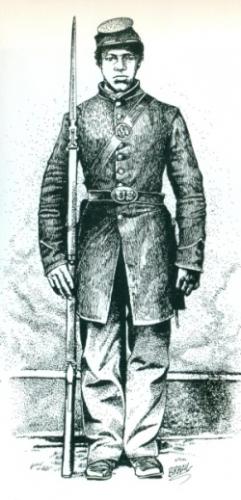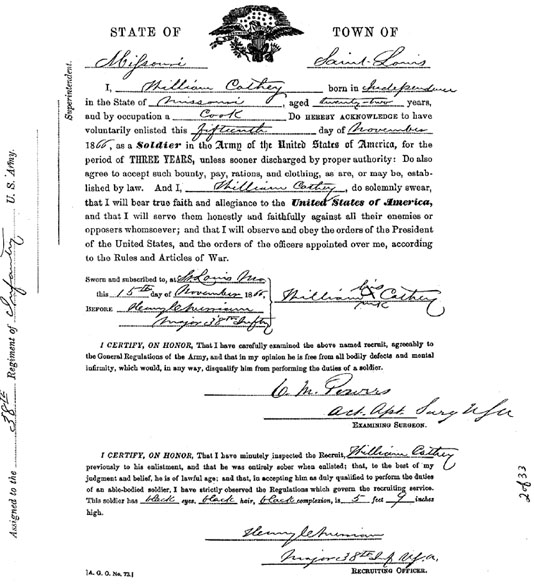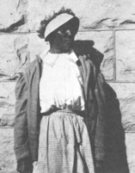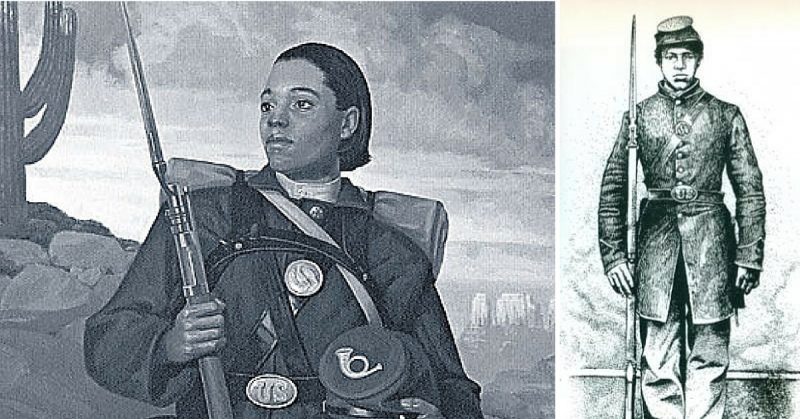Cathay Williams was pressed into service in 1861 by the Union Army in Missouri, enlisted as a man in 1866, and served in the Indian Wars as a Buffalo Soldier – the first and only female ever to do so.
Pressed into service
“While I was a small girl my master and family moved to Jefferson City. My master died there and when the war broke out and the United States soldiers came to Jefferson City they took me and other colored folks with them to Little Rock. Colonel Benton of the 13th army corps was the officer that carried us off. I did not want to go.”
Cathay was 17 years old when the Union Army pressed her into service as a laundress and cook. They had taken Jefferson City and had, as they did in all cases with former slaves, classified the enslaved people there as contraband. Contraband slaves were mostly conscripted as soldiers and support workers in the Union Army. Eventually, the Army paid them wages and taught many of them to read and write.
Travelling far and wide
When Cathay was conscripted for the Union Army she first traveled to Little Rock, AR. She was assigned first to Colonel Thomas Hart Benton and then later to General Philip Sheridan with whom she would travel extensively. They went to Washington, D.C., were present at the Shenandoah Valley Raids, and then traveled to Iowa, Missouri, Louisiana, and Georgia, hitting the major cities in each of those states.
“I saw the soldiers burn lots of cotton and I was at Shreveport when the rebel gunboats were captured and burned on Red River. We afterward went to New Orleans, then by way of the Gulf to Savannah, Georgia, then to Macon and other places in the South.”
Enlisting for independence
When the war ended in 1865, Cathay was working at the Jefferson Barracks in St. Louis. Employment opportunities for African-Americans were scarce.
As a soldier, Cathay knew that in addition to earning an income, she would also receive health benefits, opportunities for education, and eventually a pension. She also knew that women were not allowed to enlist.
There were far more pros than cons, however, and Cathay was determined to make a good life for herself. She said of her decision to enlist, “I wanted to make my own living and not be dependent on relations or friends.”
A convincing disguise, a well-kept secret

Cathay must have been brave. She had been serving the military for five years when in 1866 she disguised herself as a man and went to the recruitment office to enlist. She even told the recruiter she was a cook. It’s possible that she was banking on the probability that the men she worked with had not taken much notice of her because she was a black servant.
At any rate, she went through the recruitment process which included a physical examination – which she passed.
The recruiter assigned her to the 38th U.S. Infantry, Company A as William Cathay, a 22-year-old, 5’9, black-eyed cook with black hair and black complexion.
Her cousin and a friend, both male, served with her and kept her secret.
“The regiment I joined wore the Zouave uniform and only two persons, a cousin and a particular friend, members of the regiment, knew that I was a woman. They never ‘blowed’ on me. They were partly the cause of my joining the army.”

Constantly fighting physical illness
Cathay served the military for five years, trudging through the insect and disease heavy South, sleeping outdoors, and living through raids, before her enlisted service as a man began.
With this in mind, it should never be thought that because she was ill and “feeble” during her enlisted service that she was anything but tough as nails.
The Jefferson Barracks were an ideal breeding ground for infectious disease. Units were coming and going and it was located near the Mississippi river so that mosquitos and heavy humidity could carry and support sickness. Cathay unfortunately “was then taken with the smallpox” right after her enlistment. She was seriously ill, her body covered in small red blisters. She was taken across the river to East St. Louis for hospitalization. She had to keep her gender concealed from nurses and doctors for months until she recovered.
When she was well, she rejoined her unit in New Mexico where they were fighting the Apache. Smallpox, the New Mexico heat, the skirmishes with outlaws and Indians all took their toll on a woman who had worked terribly hard her entire life. She was hospitalized several times between 1866 and 1868 when her gender was finally discovered.
An Honorable Discharge
There is no doubt that this woman struggled through what most people today would not be able to stand for half a day. The hard work and rough living eventually caught up with her and she just couldn’t take it anymore.
“I carried my musket and did guard and other duties while in the army, but finally I got tired and wanted to get off. I played sick, complained of pains in my side, and rheumatism in my knees. The post surgeon found out I was a woman and I got my discharge.”
The men on post were not very accepting of Cathay as a woman as she noted when she said, “The men all wanted to get rid of me after they found out I was a woman. Some of them acted real bad to me.”
The Commander, however, must have been somewhat kind, at least for the era. He gave her an honorable disability discharge and referred to her with male pronouns, saying that she was “feeble both physically and mentally, and much of the time unfit for duty. The origin of his infirmities is unknown to me.”
Marriage to a scoundrel
Cathay left service and took on a job as a cook for a colonel at a nearby fort. From there, she moved to Pueblo, Colorado working odd jobs as a seamstress, laundress, and cook. That is where she married her one and only husband.
Her marriage was short-lived and ended when he turned out to be of “no account.”
“He stole my watch and chain, a hundred dollars in money and my team of horses and wagon. I had him arrested and put in jail, and then I came here [Trinidad, CO].”
A time of contentment
Cathay changed her name to Kate Williams and loved life in Trinidad, Colorado. She dreamed of owning her own land and of never “returning to the states”.
Her story was reported in the St. Louis Daily Times in January of 1876. The reporter recorded her plans for the future, “I like this town. I know all the good people here, and I expect to get rich yet. I have not got my land warrant. I thought I would wait till the railroad came and then take my land near the depot. Grant owns all this land around here, and it won’t cost me anything. I shall never live in the states again.”
Denied a military pension
The illnesses she had suffered, and subsequent diabetes and neuralgia left her infirm and missing all of her toes in later life. She spent a year and a half in the hospital.
Cathay applied for a pension but the pension doctor and medical notes included in her discharge papers led to her being denied.
The post surgeon in New Mexico had written that her illnesses predated her enlistment. Sadly, there isn’t any note that she had been serving the Army as a servant before enlistment.
The physician performing her physical for disability pension application was either apathetic or cruel.
She was listed as being 49 years old, 160 pounds, 5’7 in height and missing all of her toes which required her to walk with a crutch. His report also stated that she was in good general health and that her impairments from the toe amputation were permanent but that her disability rating was “nil”.
Her pension claim was rejected on the basis that her “feeble condition” predated her service, that her enlistment was illegal, and that no disability existed.
An unknown end
Cathay’s life after her bid for pension is unknown. She had no money, was in poor health, and is supposed to have died sometime in the last decade of the 19th century. She disappears from the Trinidad census rolls after that time so historians are not sure if she died there or moved away.

Sources:
Tucker, Phillip Thomas. Cathy Williams: From Slave to Female Buffalo Soldier. Mechanicsburg, PA: Stackpole, 2002. Print.
